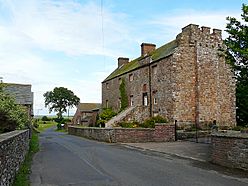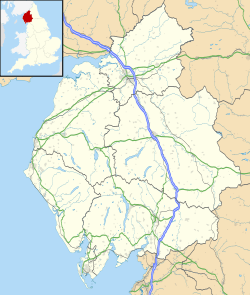Coggabata facts for kids
Quick facts for kids Coggabata |
|
|---|---|

The site of Coggabata at Drumburgh. This fortified farmhouse, Drumburgh Castle, is built with stones from the old Roman wall.
|
|
| Alternative name(s) | Congavata, Concavata |
| Known also as | Drumburgh |
| Location | |
| Coordinates | 54°55′37″N 3°08′53″W / 54.927°N 3.148°W |
| County | Cumbria |
| Country | England |
| Reference | |
| UK-OSNG reference | NY265598 |
Coggabata, also known as Congavata or Concavata, was an ancient Roman fort. Today, its site is called Drumburgh. This fort was an important part of Hadrian's Wall. It was located between two other Roman forts: Aballava (modern Burgh by Sands) to the east and Mais (Bowness-on-Solway) to the west.
Coggabata was built on a small hill. This spot gave the Romans a great view of the flat land around it. They could also see the Solway Firth to the north. The fort's main job was to guard two important crossing points. These points were called the Stonewath and the Sandwath. They were shallow areas in the Solway Firth that people could cross.
Ancient Roman records give different names for the fort. One old document, the Notitia Dignitatum, calls it 'Congavata'. Another important Roman artifact, the Rudge Cup, lists the fort as 'Coggabata'.
What Did the Fort Look Like?
The fort was shaped like an oblong. It was built using strong stone. Hadrian's Wall itself ran along the northern side of the fort. The fort measured about 82 meters (270 feet) from north to south. It was about 96 meters (316 feet) from east to west. This means it covered an area of just under 0.8 hectares (2 acres).
The part of Hadrian's Wall at Coggabata was quite wide. It measured about 2.9 meters (9 feet 7 inches) across. This section of the wall was made of stone. It was built on top of an earlier version of the wall. This first wall was made of turf (grass and soil).
The fort had gates on all four sides. The north gate allowed soldiers to go beyond the main wall. Special photography, called LIDAR, has shown an old Roman road. This road connected Coggabata to another Roman fort. That fort was at Kirkbride, to the southwest.
Today, a manor house called Drumburgh Castle stands on the site. It is built right over where the north wall of the fort used to be. All the stones used to build this castle came from the old Roman fort.
Who Guarded the Fort?
The Notitia Dignitatum, an ancient Roman military record, tells us about the soldiers stationed here. It says the fort was guarded by the Second Cohort of Lingones. A "cohort" was a group of Roman soldiers. However, Coggabata was a small fort. This means only a part, or a "detachment," of this cohort could have stayed there.
Digging Up the Past: Excavations
Archaeologists have dug up the site of Coggabata several times. These digs are called excavations. The first major excavation happened in 1899. During this dig, the stone fort was uncovered. They also found a strong building inside the fort. This building was a "granary," used for storing grain. It had extra supports, called buttresses, on its walls.
More excavations took place in 1947. These digs showed something interesting. The stone fort was built inside an even older, slightly larger fort. This older fort had walls made of clay. These clay walls had been flattened before the stone fort was built.
Experts believe the earthwork fort was added to the first version of Hadrian's Wall. That first wall was made of turf. Later, when the turf wall was rebuilt with stone, the stone fort replaced the earthwork one. This suggests the stone fort was built around 160 AD.
So far, archaeologists have not found any signs of a "vicus" near the fort. A vicus was a small civilian settlement. It would have been a village where families of soldiers and traders lived outside the fort.


